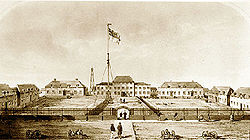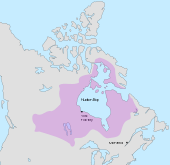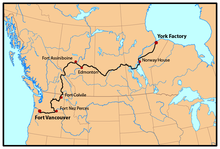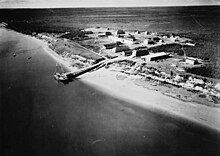York Factory
| York Factory | |
|---|---|
 York Factory in 1853 | |
| Location | Manitoba, Canada |
| Area | 102 hectares (250 acres) |
| Founder | Hudson's Bay Company |
| Built | 1788 to 1850 |
| Original use | Fort, military structure, fur trading post |
| Governing body | Parks Canada |
| Website | parks |
| Designated | 1936 |
York Factory was a settlement and Hudson's Bay Company (HBC) factory (trading post) located on the southwestern shore of Hudson Bay in northeastern Manitoba, Canada, at the mouth of the Hayes River, approximately 200 kilometres (120 mi) south-southeast of Churchill.
York Factory was one of the first fur-trading posts established by the HBC, built in 1684 and used in that business for more than 270 years. The settlement was headquarters of the HBC's Northern Department from 1821 to 1873.[1] The complex was designated a National Historic Site of Canada in 1936.[2]
In 1957, the HBC closed it down. It has been owned by the Canadian government since 1968 and the site is now operated by Parks Canada. No one lives permanently at York Factory; there is a summer residence for Parks Canada staff, and some nearby seasonal hunting camps. The wooden structure at the park site dates from 1831 and is the oldest and largest wooden structure built on permafrost in Canada.
Location
York Factory is located on the north bank of the Hayes River about 11 kilometres (7 miles) inland. The mouth of the Nelson River is to the north, across "Point of Marsh". The Hayes is a more practical canoe route, although the Nelson is much larger (it drains Lake Winnipeg). Seagoing ships anchored at Five Fathom Hole 11 km (7 mi) from the fort due to the shallow bottom, and goods were transferred by smaller boats.The Shamattawa Airport and Gillam Airport are nearby today.[3]
History





From the 17th to the late 19th century, the depot at York Factory and its predecessors were the central base of operations for the Hudson's Bay Company's (HBC) control of the fur trade and other business dealings with the First Nations throughout Rupert's Land, the vast territory comprising the entire watershed of Hudson Bay, and which now forms much of Canada.
The first three HBC posts were established on
From 1788 to 1795, the company constructed a square bastion fort of stone and brick at York Factory. The fort was known as The Octagon” because of the octagonal shape of the area enclosed. The choice of material was poor, however, as the stone and brick could not stand up to heaving permafrost, and in 1831, the stone fort was razed. The three-story center section of the current compound was completed that same year, with the two-story wings finished within the two years that followed.
During its first century, the depot operated by drawing First Nations traders to the post, rather than sending its own traders out into the field. Its position at the mouth of the Nelson allowed access by canoe from the watersheds of the Saskatchewan and Red rivers.
In the late 18th century, the centralized nature of the
By the mid-19th century, York Factory had developed an extensive trading post and settlement with 50 on-site buildings, most of which have been destroyed, and a permanent workforce. However, it was not a beloved location. The chief trader, John McLean, wrote that he "took leave of Fort York, its fogs, and bogs and mosquitoes, with little regret" in 1837.[4] Moreover, the reign of York Factory as one of the most important Hudson Bay Company posts declined in 1860s and 1870s because of the transfer of Rupert's Land to Canada and the changes in the HBC Northwest transportation network that increased the use of the United States railways, steamboats, and Red River carts for Upper Fort Garry's southern supply line. The depot remained in company hands after the acquisition of Rupert's Land by Canada in 1870. In 1872, York Factory's role diminished to outfitting only to particular posts in Manitoba. The post's fur trade headquarters title was removed a year later, and certain responsibilities were transferred to Upper Fort Garry, present-day Winnipeg.[5]
The importance of York Factory declined further. From 1874 to 1875, the post virtually stopped receiving supplies and goods to be transported elsewhere. The following years, specifically 1878, the post's British products began being relocated to Norway House.[6] York Factory had a brief upswing when it was designated the headquarters for the new Nelson River District in 1911. However, the Factory lost the title in 1929 to Churchill due to the establishment of the railway line that connected Churchill to Winnipeg. From that point forward, York Factory served as a regional trading post.[5]
In 1957, Hudson's Bay York Factory closed. The residents were relocated to York Landing Cree Nation,[7] about 116 kilometres (72 mi) ENE of Thompson, Manitoba, as well as Split Lake and Shamattawa. In oral stories, Cree elders who once resided at York Factory in the first half of the twentieth century recalled their desires to remain at Kihci-waskahikan or Great House when operations ceased. Kihci-waskahikan and Great House are words for the post used by the Swampy Cree, West Main Cree, Lowland Cree, and/or Home Guard Cree.[8]
The historic site is currently staffed by Parks Canada from June 1 to mid-September. Archaeological excavations of the 18th-century "octagon" have been conducted since 1991.
See also
References
- ^ Pannekoek, Frits (February 7, 2006). "York Factory". The Canadian Encyclopedia (online ed.). Historica Canada. Retrieved October 5, 2015.
- ^ York Factory National Historic Site of Canada. Canadian Register of Historic Places. Retrieved 6 December 2016.
- ^ "About Us". Archived from the original on January 16, 2016. Retrieved June 8, 2014.
- ^ Boyle, David (1892), "Notes on the Discoverer of the Great Falls of Labrador", Transactions of the Canadian Institute, vol. II, Toronto: Copp, Clark Co, p. 335.
- ^ ISBN 0-7735-1440-6. Retrieved October 5, 2015.
- ISBN 0-8020-8196-7. Retrieved October 5, 2015.
- ^ "About Us". York Factory First Nation. Archived from the original on March 22, 2012. Retrieved May 16, 2011.
- ^ Beardy & Coutts (1996), pp. xi & xvi
Secondary sources
- Newman, Peter C. (1998). The Empire of the Bay.
